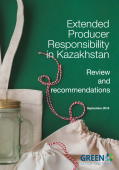
This report analyses the current legal framework and operational set-up for Extended Producer Responsibility (EPR) in Kazakhstan and makes recommendations for strengthening and improving the current system further.

This paper summarises key concepts relating to trade-offs and synergies, including trade-off analysis and management, to make approaches and methods more accessible.
The Agricultural Outlook 2019-2028 is a collaborative effort of the Organisation for Economic Co-operation and Development (OECD) and the Food and Agriculture Organization (FAO) of the United Nations. It brings together the commodity, policy and country expertise of both organisations as well as input from collaborating member countries to provide an annual assessment of the prospects for the coming decade of national, regional and global agricultural commodity markets. This year's Special Feature will focus on agricultural development in Latin America.
The Agricultural Outlook 2019-2028 is a collaborative effort of the Organisation for Economic Co-operation and Development (OECD) and the Food and Agriculture Organization (FAO) of the United Nations. It brings together the commodity, policy, and country expertise of both organisations as well as input from collaborating member countries to provide an annual assessment of the prospects for the coming decade of national, regional, and global agricultural commodity markets. This year's Special Feature focuses on agricultural development in Latin America.
Food companies are not only at risk due to water scarcity, they are also responsible for it. Agriculture is rapidly draining aquifers in many regions of the world, and meat production is one of the biggest polluters of watersheds globally. This report provides investors with guidance and relevant data for evaluating the water risk management of 40 major companies in the agricultural products, beverage, meat, and packaged food industries. It also tracks their progress in managing their water risks as compared to performance in 2017 and 2015. This analysis can help food companies manage their water risks more effectively, which is critically important to their bottom lines.
